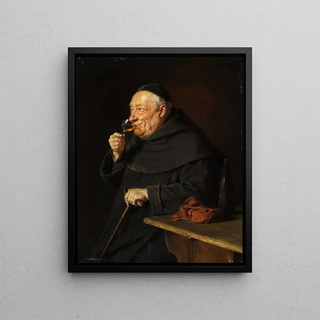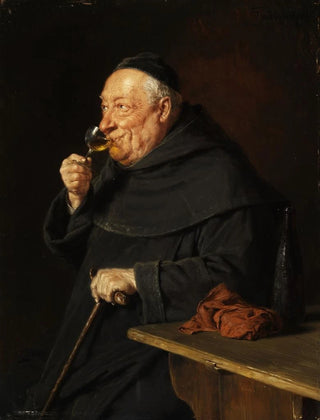Art print | Benedictine monk with wine at breakfast - Eduard von Grützner Source: Reproduction | Moine bénédictin avec du vin au petit déjeuner - Eduard von Grützner


View from behind

Frame (optional)
Art print of a Benedictine monk with wine at breakfast - Eduard von Grützner – Captivating introduction
In the rich and fascinating universe of art, certain works stand out for their ability to capture simple yet profound moments of life. The art print "Benedictine monk with wine at breakfast" by Eduard von Grützner is a perfect example. This painting invites the viewer to delve into the intimacy of a monk, revealing a daily scene where wine, a symbol of conviviality and sharing, blends with the spirituality of monastic life. Through this piece, the artist offers us a window into a bygone era, while encouraging reflection on the relationship between faith, human nature, and the simple pleasures of life.
Style and uniqueness of the work
Eduard von Grützner is known for his unique style that combines realism with a certain lightness of tone. In "Benedictine monk with wine at breakfast," he manages to create a warm and welcoming atmosphere. The warm colors, subtly orchestrated play of light, and the meticulous details of the monk’s clothing and accessories demonstrate remarkable technical skill. The expression of the monk, both serene and joyful, reinforces the idea of a monastic life where pleasure is not excluded from devotion. This work, while rooted in an artistic tradition, stands out for its humanism, highlighting the joy of living even within a religious setting.
The artist and his influence
Eduard von Grützner, a German painter of the 19th century, established himself as an emblematic figure of the artistic movement of his time. Trained at the Academy of Fine Arts in Munich, he developed a style focused on depicting everyday life, particularly within monasteries. His work is often marked by a humorous and satirical approach, allowing him to reach a broad audience. Grützner was able to capture not only the essence of his subjects but also the spirit of his era, addressing universal themes such as conviviality, meditation, and the joy of living. His influence endures, inspiring many artists who seek

Matte finish

View from behind

Frame (optional)
Art print of a Benedictine monk with wine at breakfast - Eduard von Grützner – Captivating introduction
In the rich and fascinating universe of art, certain works stand out for their ability to capture simple yet profound moments of life. The art print "Benedictine monk with wine at breakfast" by Eduard von Grützner is a perfect example. This painting invites the viewer to delve into the intimacy of a monk, revealing a daily scene where wine, a symbol of conviviality and sharing, blends with the spirituality of monastic life. Through this piece, the artist offers us a window into a bygone era, while encouraging reflection on the relationship between faith, human nature, and the simple pleasures of life.
Style and uniqueness of the work
Eduard von Grützner is known for his unique style that combines realism with a certain lightness of tone. In "Benedictine monk with wine at breakfast," he manages to create a warm and welcoming atmosphere. The warm colors, subtly orchestrated play of light, and the meticulous details of the monk’s clothing and accessories demonstrate remarkable technical skill. The expression of the monk, both serene and joyful, reinforces the idea of a monastic life where pleasure is not excluded from devotion. This work, while rooted in an artistic tradition, stands out for its humanism, highlighting the joy of living even within a religious setting.
The artist and his influence
Eduard von Grützner, a German painter of the 19th century, established himself as an emblematic figure of the artistic movement of his time. Trained at the Academy of Fine Arts in Munich, he developed a style focused on depicting everyday life, particularly within monasteries. His work is often marked by a humorous and satirical approach, allowing him to reach a broad audience. Grützner was able to capture not only the essence of his subjects but also the spirit of his era, addressing universal themes such as conviviality, meditation, and the joy of living. His influence endures, inspiring many artists who seek






